
The John Newbery Medal, frequently shortened to the Newbery, is a literary award given by the Association for Library Service to Children (ALSC), a division of the American Library Association (ALA), to the author of "the most distinguished contributions to American literature for children". The Newbery and the Caldecott Medal are considered the two most prestigious awards for children's literature in the United States. Books selected are widely carried by bookstores and libraries, the authors are interviewed on television, and master's theses and doctoral dissertations are written on them. Named for John Newbery, an 18th-century English publisher of juvenile books, the winner of the Newbery is selected at the ALA's Midwinter Conference by a fifteen-person committee. The Newbery was proposed by Frederic G. Melcher in 1921, making it the first children's book award in the world. The physical bronze medal was designed by Rene Paul Chambellan and is given to the winning author at the next ALA annual conference. Since its founding there have been several changes to the composition of the selection committee, while the physical medal remains the same.
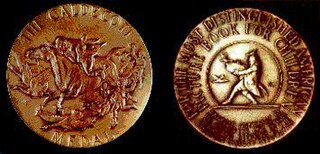
The Randolph Caldecott Medal, frequently shortened to just the Caldecott, annually recognizes the preceding year's "most distinguished American picture book for children". It is awarded to the illustrator by the Association for Library Service to Children (ALSC), a division of the American Library Association (ALA). The Caldecott and Newbery Medals are considered the most prestigious American children's book awards. Beside the Caldecott Medal, the committee awards a variable number of citations to runners-up they deem worthy, called the Caldecott Honor or Caldecott Honor Books.
John Robert McCloskey was an American writer and illustrator of children's books. He both wrote and illustrated eight picture books, and won two Caldecott Medals from the American Library Association for the year's best-illustrated picture book. Four of the eight books were set in Maine: Blueberries for Sal, One Morning in Maine, Time of Wonder, and Burt Dow, Deep-water Man. His best-known work is Make Way For Ducklings, set in Boston. In longer works, he both wrote and illustrated Homer Price and he illustrated Keith Robertson's Henry Reed series.
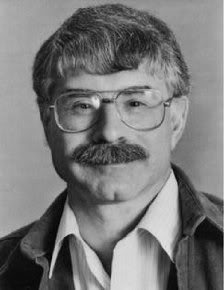
Arnold Stark Lobel was an American author of children's books, including the Frog and Toad series and Mouse Soup. He wrote and illustrated these picture books as well as Fables, a 1981 Caldecott Medal winner for best-illustrated U.S. picture book. Lobel also illustrated books by other writers, including Sam the Minuteman by Nathaniel Benchley published in 1969.

The Boston Globe–Horn Book Awards are a set of American literary awards conferred by The Boston Globe and The Horn Book Magazine annually from 1967. One book is recognized in each of four categories: Fiction and Poetry, Nonfiction, and Picture Book. The official website calls the awards "among the most prestigious honors in children's and young adult literature".

Kevin Henkes is an American writer and illustrator of children's books. As an illustrator he won the Caldecott Medal for Kitten's First Full Moon (2004). Two of his books were Newbery Medal Honor Books, Olive's Ocean in 2004 and The Year of Billy Miller in 2014. His picture book Waiting was named both a 2016 Caldecott Honor Book and a Geisel Honor Book. It was only the second time any author has won that combination of awards.

David Wiesner is an American illustrator and writer of children's books, known best for picture books including some that tell stories without words. As an illustrator he has won three Caldecott Medals recognizing the year's "most distinguished American picture book for children" and he was one of five finalists in 2008 for the biennial, international Hans Christian Andersen Award, the highest recognition available for creators of children's books.

Chris Raschka is an American illustrator, writer, and violist. He contributed to children's literature as a children's illustrator. He was U.S. nominee for the biennial, international Hans Christian Andersen Medal in 2012.
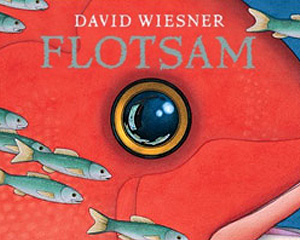
Flotsam is a children's wordless picture book written and illustrated by David Wiesner. Published by Clarion/Houghton Mifflin in 2006, it was the 2007 winner of the Caldecott Medal; the third win for David Wiesner. The book contains illustrations of underwater life with no text to accompany them.
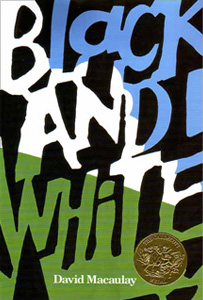
Black and White is a 1990 postmodern children's picture book by David Macaulay. Published by Houghton Mifflin Company, it received mixed reviews upon its release, but it was the recipient of the Caldecott Medal for illustration in 1991. The book tells four overlapping stories, each drawn with a distinct visual style. The four stories are "Seeing Things", about a boy on a train trip by himself, "Problem Parents", about siblings whose parents behave differently one night, "A Waiting Game", about people waiting for a train, and "Udder Chaos", about cows who escape and then return to their field.
Vera Baker Williams was an American children's writer and illustrator. Her best known work, A Chair for My Mother, has won multiple awards and was featured on the children's television show Reading Rainbow. For her lifetime contribution as a children's illustrator she was U.S. nominee in 2004 for the biennial, international Hans Christian Andersen Award, the highest recognition available to creators of children's books. Additionally, she was awarded the 2009 NSK Neustadt Prize for Children's Literature.

The Lion & the Mouse is a 2009 nearly wordless picture book illustrated by Jerry Pinkney. This book, published by Little, Brown and Company, tells Aesop's fable of The Lion and the Mouse. In the story, a mouse's life is a spared by a lion. Later, after the lion is trapped, the mouse is able to set the lion free. Adapting the fable, with the moral that the weak can help the strong, as a wordless picture book was seen as a successful way of overcoming the brief plot generally found in the source stories. While it was Pinkney's first wordless picture book, it was not the first time he had told the story, having previously included it in his Aesop's Fables, published in 2000. Pinkney, who had received five Caldecott Honors, became the first African American to win the Caldecott Medal for his illustrations in this book. His illustrations were generally praised for their realism and sense of place. The cover illustrations, featuring the title characters but no text, drew particular praise.

A Sick Day for Amos McGee is a 2010 children's picture book written by Philip C. Stead and was illustrated by Erin E. Stead. The book, published by Roaring Brook Press, depicts a zookeeper who has bonded with the animals he cares for and who come and visit him one day when he gets sick. Phillip Stead wrote the book hoping his wife Erin would illustrate it after a period where she had become discouraged with her art. The book was well reviewed, and Erin won the 2011 Caldecott Medal for her illustrations. The book received praise for its woodblock illustrations and for its message about what friends will do to help and support each other.

Jon Klassen is a Canadian writer and illustrator of children's books and an animator. He won both the American Caldecott Medal and the British Kate Greenaway Medal for children's book illustration, recognizing the 2012 picture book This Is Not My Hat, which he also wrote. He is the first person to win both awards for the same work.

Locomotive is a 2013 children's book written and illustrated by Brian Floca. A non-fiction book written primarily in free verse, the book follows a family as they ride a transcontinental steam engine train in summer of 1869. The book details the workers, passengers, landscape, and effects of building and operating the first transcontinental railroad. The book also contains prose about the earlier and later history of locomotives. The book took Floca four years to create, which included a change in perspective from following the crew of the train to following a family. Floca conducted extensive research including his own train ride and consultation with experts to ensure he had the details all correct.

This Is Not My Hat is a 2012 American children's picture book by the author and illustrator Jon Klassen. The story is told through the unreliable narration of a little fish, who has stolen a hat from a big fish and how the big fish reacts to the theft. It is a thematic follow-up to I Want My Hat Back (2011) and was meant to be a more literal sequel until Klassen took a suggestion to change which animals were in the story. The book was well received by critics who praised its dark or ironic humor which could only be understood by comparing the words of the little fish's narration against the events of the illustrations. In addition to several positive reviews, Klassen received the 2013 Caldecott Medal and the 2014 Kate Greenaway Medal becoming the first book to win both awards. This is Not My Hat was also a commercial success.
Melissa Sweet is an American illustrator and writer of children's books of nearly 100 books.

Wolf in the Snow is a 2017 wordless picture book by Matthew Cordell. The book was favorably received by critics and won the 2018 Caldecott Award. The story has drawn comparisons to fairy tales like Little Red Riding Hood. The nearly wordless book tells the story of a girl and wolf who each get lost in the snowstorm. Cordell used distinctive illustration techniques for the girl and the wolf.

The Rough Patch is a 2018 picture book by Brian Lies. An idea of Lies' for more than ten years, when it was published it was well received and was named a 2019 Caldecott Honor book. The story tells of a fox named Evan whose dog dies. Evan then experiences various emotions while grieving before adopting a new dog at the end of the book. The book was praised for Lies' mixed media illustrations, in particular the way he used light and shadow.
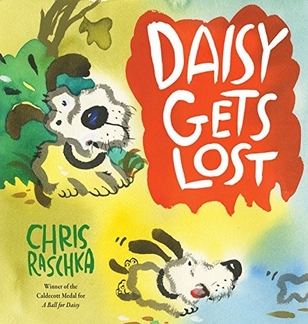
Daisy Gets Lost is a 2013 children's picture book by Chris Raschka. It is a sequel of the 2011 book A Ball for Daisy and is about Daisy chasing a squirrel, becoming lost in a forest, but then being reunited with her owner.

















